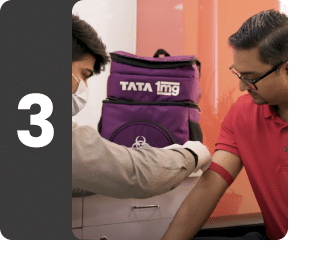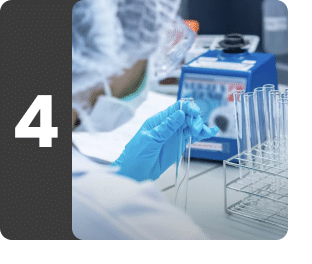Coagulation Profile near me in Dehradun
Understanding Coagulation Profile in Dehradun
What is Coagulation Profile in Dehradun?
Coagulation profile helps to determine the concentration of coagulation factors in the blood. It helps to assess the blood's ability to dissolve a clot as well as its clotting time. It is useful for evaluating the risk of excessive bleeding or developing clots (thrombosis).This profile includes two tests, Activated Partial Thromboplastin Time test and Prothrombin Time test.
This profile is recommended for the diagnosis of bleeding or clotting disorders, before a surgery, to patients undergoing the treatment for these diseases.
It is also suggested as a screening test before conceiving to mitigate the risk of birth defects in a baby.
What does Coagulation Profile measure?
Contains 2 testsCoagulation profile measures the activated partial thromboplastin time and prothrombin time.
Prothrombin is a protein which is produced by the liver. Prothrombin time determines the time your blood will take to clot. The Prothrombin time increases in case the patient is on blood-thinning medications or has hemophilia or liver disease. Malabsorption of the prothrombin protein may also affect the results of prothrombin time. This test is also done in patients who are taking medicines that affect the clotting time such as warfarin.
The doctor advises the prothrombin test with another clotting test known as activated partial thromboplastin time (aPTT).
The aPTT is also known as PTT (Partial Thromboplastin Time). The aPTT test helps to determine the ability of a person to form blood clots appropriately. The aPTT test measures the number of seconds taken by a clot to form in a sample of blood after the addition of reagents. This test assesses the amount and function of clotting factors.
Hemostasis is the process which is initiated by the body when there is an injury to the body tissues or walls of blood vessels. In this process, the platelets combine at the site of injury and a simultaneous process of coagulation gets activated, leading to further activation of the coagulation factors. As a result of this process, the fibrin threads are formed which form a net and get attached to the site of injury. This helps in stabilizing the site of injury, further leading to the formation of a stable blood clot to seal off the injury to blood vessels. It also helps in the prevention of additional blood loss which allows the damaged areas to heal.
The PTT evaluates the coagulation factors XII, XI, IX, VIII, X, V, II (prothrombin), and I (fibrinogen) as well as prekallikrein (PK) and high molecular weight kininogen (HK).
A PT test evaluates the VII, X, V, II, and I coagulation factors.

Prothrombin Time International Normalized Ratio
The Prothrombin Time (PT) Test measures the ability of the plasma to clot in order to detect a bleeding disorder or clotting disorder and to monitor the effects of anticoagulant medication, Warfarin.
In case of any bleeding, the body responds to stop the blood loss as quickly as possible by forming a blood clot. This process of blood clotting or coagulation is called hemostasis and involves a series of chemical reactions in the blood (coagulation cascade) which activates blood proteins called coagulation factors one after another, in a series. The activated coagulation factors lead to the formation of fibrin mesh around the platelets and other blood cells at the site of bleeding and this complex hardens to form a “blood clot”.
Coagulation cascade proceeds by two pathways, the intrinsic pathway, and the extrinsic pathway. These pathways later merge together into a common pathway. Prothrombin (Coagulation Factor II) is converted to its active form thrombin in one of the reactions. The PT Test assesses the functioning of Blood Coagulation Factors I, II, V, VII, and X, which are parts of the extrinsic and common pathways by measuring the time taken for conversion of prothrombin to thrombin. The Activated Partial Thromboplastin Time (aPTT) Test measures the functioning of Blood coagulation Factors I, II, V, XII, VIII, IX, X, and XI, along with other factors Prekallikrein (PK), and High Molecular Weight Kininogen (HK) which form parts of the intrinsic and common coagulation pathways. The PT and aPTT tests are usually performed together and the results of both are evaluated simultaneously to determine the rate of blood clotting.
Warfarin is prescribed in the treatment of conditions caused or worsened by excessive blood clotting like Deep Vein Thrombosis (blood clot formation in blood vessels), irregular heartbeats, etc. The PT test is also performed to evaluate the effectiveness of Warfarin treatment. When performed to determine Warfarin efficacy, the result of the PT Test is expressed in terms of a measurement scale called the International Normalized Ratio (INR). Since the PT Tests are performed using different reagents in different labs giving rise to widely varying results in other conventional units, the INR system was created to maintain uniformity in the results.
Know more about Prothrombin Time International Normalized Ratio

Activated Partial Thromboplastin Time
The Activated Partial Thromboplastin Time (aPTT) test measures the time taken by the blood to form a clot after the addition of substances (reagents) which activate the clot formation.
In case of any bleeding, the body responds to stop the blood loss as quickly as possible by forming a blood clot. This process of blood clotting or coagulation is called hemostasis and involves a series of chemical reactions in the blood (coagulation cascade). During this process, the blood proteins called coagulation factors get activated one after another in a series. The activated coagulation factors lead to the formation of fibrin mesh around the platelets and other blood cells at the site of bleeding and this complex hardens to form a “blood clot”.
Coagulation cascade proceeds by two pathways, the intrinsic pathway, and the extrinsic pathway. These pathways later merge together into a common pathway. The Activated Partial Thromboplastin Time (aPTT) test measures the functioning of Blood Coagulation Factors I, II, V, XII, VIII, IX, X, and XI, along with other factors Prekallikrein (PK), and High Molecular Weight Kininogen (HK) which form parts of the intrinsic and common coagulation pathways.
The Activated Partial Thromboplastin Time (aPTT) test measures the time taken by the blood to form a clot after the addition of substances (calcium and phospholipid emulsion) which activate clotting. The aPTT test result is compared to a control sample of normal blood.
The aPTT test is usually performed along with Prothrombin Time (PT) test to evaluate the cause of a coagulation defect, if any. PT test assesses the functioning of Blood Coagulation Factors I, II, V, VII, and X, which are parts of the extrinsic and common pathways by measuring the time taken for conversion of prothrombin to thrombin.
Know more about Activated Partial Thromboplastin Time
Book a Coagulation Profile test at home near me





Other tests









